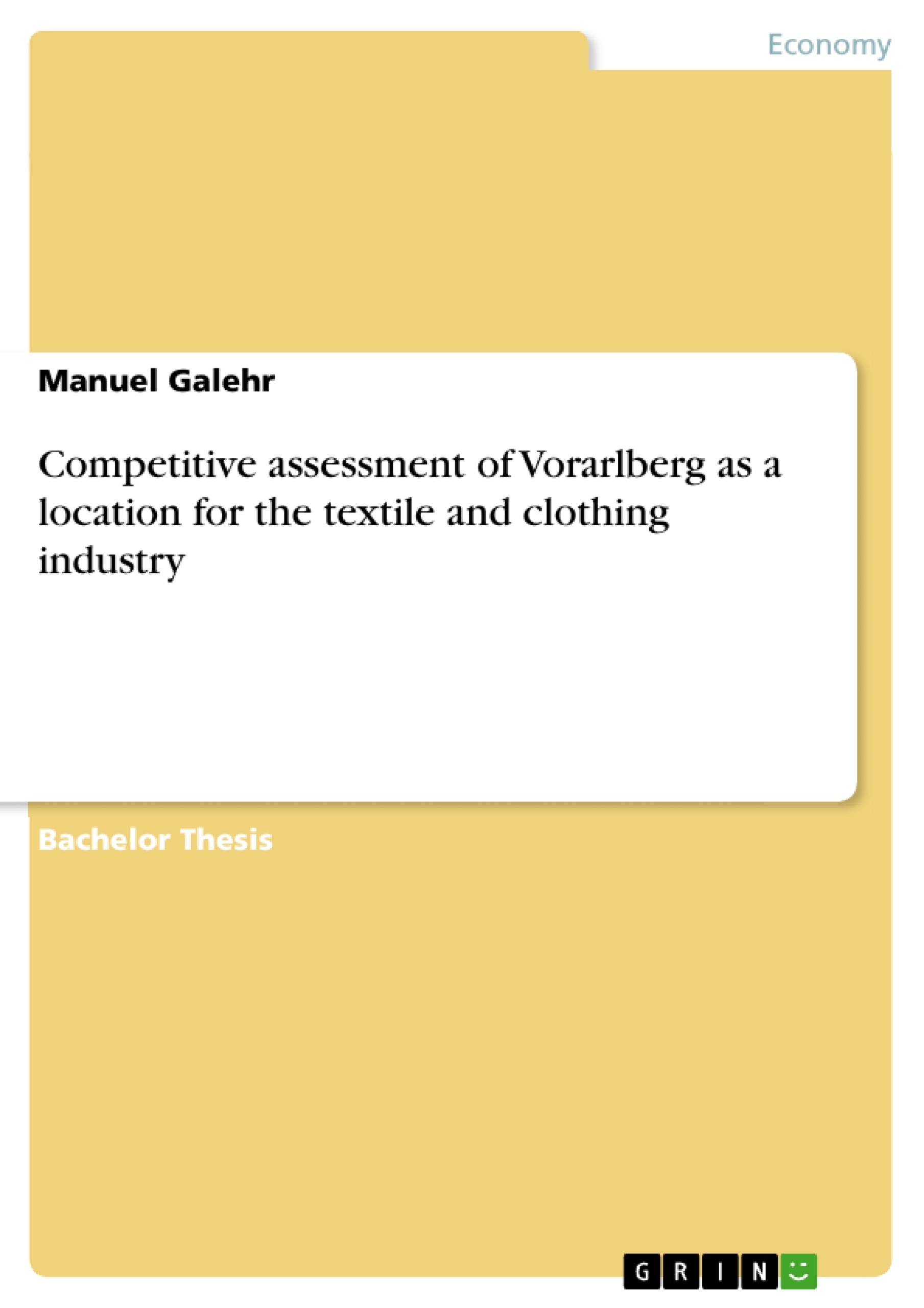Vorarlberg is marked by the legacy of the traditional textile and clothing industry. In the last decades the industry in the region has faced increasingly fierce competition especially from Asian rivals which depleted the number of companies in the industry segment. Nevertheless, the regional industry has been more resilient than industries in other European regions. This study examines the competitiveness of the location for the textile and clothing industry using the diamond framework by Porter (1990). Furthermore, viable strategies from the regional firms were analyzed.
Inhaltsverzeichnis (Table of Contents)
- Abstract
- 1. Purpose of the Research
- 1.1 Introduction
- 1.2 Problem
- 1.3 Purpose
- 2. Theoretical Background
- 2.1 Defining competitiveness
- 2.2 Level of analysis
- 2.3 Concepts of competitiveness assessment
- 2.4 Choosing a suitable model
- 2.5 Revealed Comparative Advantage
- 2.6 Porter's Diamond Model
- 2.6.1 Determinants and Variables
- 2.6.2 Relationship among the determinants
- 2.6.3 The determinants as a system
- 2.7 Competitive Strategy
- 2.7.1 The competitive environment
- 2.7.2 Generic Strategies
- 3. Methodology
- 3.1 Procedure
- 3.2 Theoretical framework
- 3.3 Propositions
- 3.4 Case study approach
- 3.5 Organizational framework
- 3.6 Data Collection
- 3.6.1 Competitive Assessment
- 3.6.2 Strategy Assessment
- 3.7 Data analysis
- 3.8 Sampling
- 3.9 Reliability and Validity
- 4. Results and Analysis
- 4.1 Diamond model
- 4.1.1 Factor Conditions
- 4.1.2 Related and Supporting Industry
- 4.1.3 Demand Conditions
- 4.1.4 Firm strategy, structure and rivalry
- 4.1.5 Government
- 4.2 Revealed comparative advantage
- 4.3 Strategy
- 4.1 Diamond model
- 5. Conclusion
Zielsetzung und Themenschwerpunkte (Objectives and Key Themes)
This study investigates the competitiveness of the textile and clothing industry in Vorarlberg, Austria, utilizing Porter's Diamond Model (1990) as a framework for analysis. The research aims to identify the strengths and weaknesses of the location, assess its competitive advantage, and analyze the strategic approaches adopted by regional firms in the industry. Key themes explored in the study include:- The historical evolution of the textile industry in Vorarlberg and the challenges it has faced in recent decades due to globalization and competition from Asian rivals.
- The application of Porter's Diamond Model to evaluate the competitiveness of Vorarlberg as a location for the textile and clothing industry, analyzing its determinants such as factor conditions, related and supporting industries, demand conditions, firm strategy, structure and rivalry, and government policies.
- The strategic choices made by firms in the region, focusing on their niche market orientation and the challenges of aligning their strategies with the changing competitive environment.
- The impact of global trade agreements, particularly the Multifiber Arrangement (MFA) and the Agreement on Textiles and Clothing (ATC), on the industry.
- The significance of labor costs and their influence on the competitive position of European textile and clothing companies in a globalized market.
Zusammenfassung der Kapitel (Chapter Summaries)
- Chapter 1 provides an introduction to the study, outlining the problem of declining employment in the textile and clothing industry in Vorarlberg and stating the purpose of the research. The chapter also reviews the historical development of the textile industry in the region, highlighting the impact of globalization and the end of the MFA on the industry.
- Chapter 2 presents the theoretical framework for the study, focusing on the concept of competitiveness, levels of analysis, and various models for assessing competitiveness. The chapter delves into Porter's Diamond Model and its determinants, as well as the concept of Revealed Comparative Advantage. It concludes with an overview of competitive strategy and its application to the textile and clothing industry.
- Chapter 3 details the methodology employed in the study, encompassing the research design, theoretical framework, propositions, case study approach, data collection methods, data analysis techniques, sampling procedures, and the assessment of reliability and validity.
- Chapter 4 presents the results of the analysis, applying Porter's Diamond Model to assess the competitive position of Vorarlberg and exploring the strategic choices made by firms in the region. It examines the factors contributing to the region's competitiveness, including factor conditions, related and supporting industries, demand conditions, firm strategy, structure and rivalry, and government policies.
Schlüsselwörter (Keywords)
This study examines the competitiveness of the textile and clothing industry in Vorarlberg, Austria, focusing on Porter's Diamond Model, competitive advantage, niche market orientation, global trade agreements, Multifiber Arrangement (MFA), Agreement on Textiles and Clothing (ATC), labor costs, and strategic alignment. It explores the impact of globalization and competition from emerging economies on the industry.
Excerpt out of 70 pages
- scroll top
- Quote paper
- Manuel Galehr (Author), 2012, Competitive assessment of Vorarlberg as a location for the textile and clothing industry, Munich, GRIN Verlag, https://www.grin.com/document/263435
Look inside the ebook



